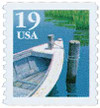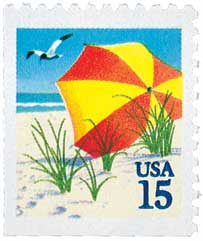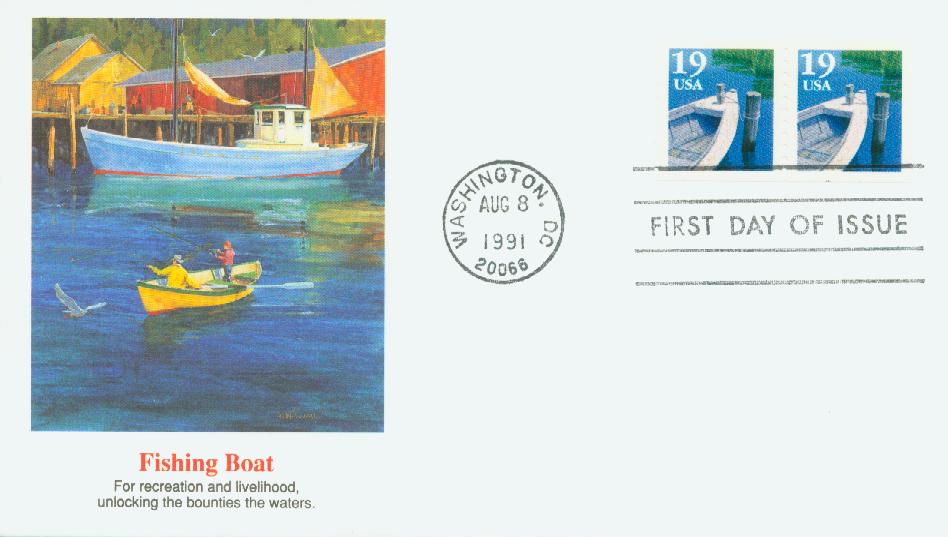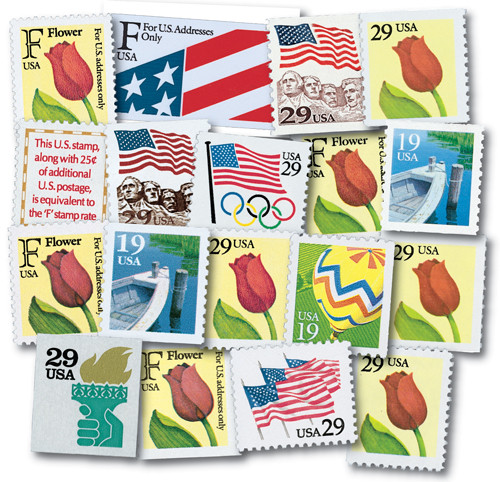
# 2529 - 1991 19c Fishing Boat, coil
US #2529
1991 Fishing Boat
- Part of the short-lived “mini-scapes” series
- Covered the Postcard rate
Category of Stamp: Definitive
Value: 19¢, Postcard rate
First Day of Issue: August 8, 1991
First Day City: Washinton, DC
Quantity Issued: 294,625,000
Printed by: Multi-Color Corporation for American Bank Note Company
Printing Method: Photogravure
Format: Coils of 500 and 3,000, from printing cylinder of 684 subjects (19 across, 36 down)
Perforations: 9.8, vertically
Reason the stamp was issued: The stamp was issued to satisfy the postcard rate. It was produced in large coils for use in post office vending machines.
About the stamp design: The artwork on the Fishing Boat stamp was made by Pierre Mion, who was also the talent behind the Beach Umbrella (#2443) and Hot-Air Balloon (#2530) stamps. The Citizens’ Stamp Advisory Committee referred to these stamps as “mini-scapes.”
The stamp shows the front (prow) of a fishing boat tied to a pier. Mion’s painting was done in gouache (opaque watercolor).
First Day City: There was no official First Day of Issue ceremony for this stamp. It was issued at the main post office in Washington, DC.
Short-Lived Mini-Scapes Series
This series has its roots in the summer of 1988 when members of the Citizens' Stamp Advisory Committee (CSAC) sought to give mailers an alternative to "bewhiskered unknowns" and Flag-over-Capitol-type scenes on definitives. The USPS had also tried picturing landmarks such as Yosemite National Park, but some felt those didn't work well on the small scale of definitive stamps.
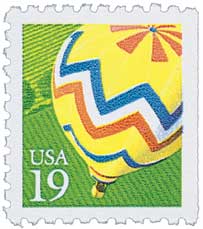
So CSAC hired three artists to come up with stamps that would be bright, cheerful, and colorful. They asked that the stamps picture "generic landscapes" found in multiple areas of the country or "tight little vignettes"of objects or scenes that would be familiar to a large number of people.

One of these artists was Pierre Mion of Virginia. He produced sketches of some of the suggested images: a hot-air balloon, a child with an umbrella, and a piggy bank. He also gave them a few sketches of his own ideas: a beach umbrella, part of a small boat, the end of a pier, and a child on a carousel. CSAC liked his sketches and then requested paintings of some of them.
Eventually, the USPS needed a new booklet stamp to cover the postcard rate, and they selected Mion's beach umbrella to appear on it. The Beach umbrella stamp would be notable for a few reasons. It was the first stamp in the new Mini-Scapes Series. It was also the first postcard-rate stamp to be issued only in booklet form for use by vacationers.

Additionally, the stamp was the first in which the phosphorescent tagging was mixed with two different colors of ink. Normally it was applied as a coating on the stamp, or in a couple rare cases, was mixed in with one ink color. The stamp was issued on February 3, 1990, in Sarasota, Florida at the Sarasota Philatelic Club's Sarapex 90 Show.
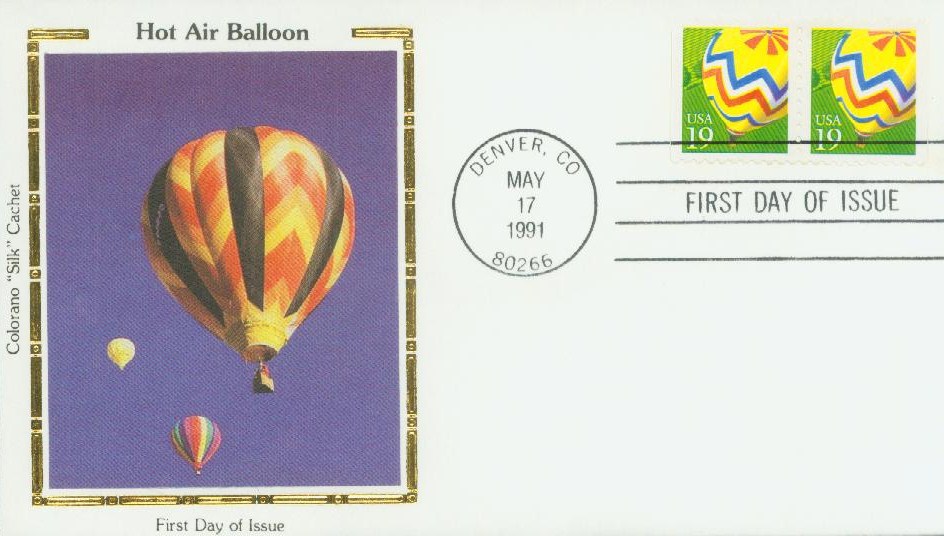
A year later, the postcard rate was raised from 15¢ to 19¢, leading the USPS to issue the second stamp in the series, picturing a hot-air balloon. That stamp, featuring art by Mion, was issued on May 17, 1991. The third and final stamp was issued three months later on August 8, and also featured artwork by Mion. It pictured the prow of a fishing boat tied to a pier along a marshy shoreline. The boat pictured is typical of an oyster or crabbing boat found along the East Coast.
US #2529
1991 Fishing Boat
- Part of the short-lived “mini-scapes” series
- Covered the Postcard rate
Category of Stamp: Definitive
Value: 19¢, Postcard rate
First Day of Issue: August 8, 1991
First Day City: Washinton, DC
Quantity Issued: 294,625,000
Printed by: Multi-Color Corporation for American Bank Note Company
Printing Method: Photogravure
Format: Coils of 500 and 3,000, from printing cylinder of 684 subjects (19 across, 36 down)
Perforations: 9.8, vertically
Reason the stamp was issued: The stamp was issued to satisfy the postcard rate. It was produced in large coils for use in post office vending machines.
About the stamp design: The artwork on the Fishing Boat stamp was made by Pierre Mion, who was also the talent behind the Beach Umbrella (#2443) and Hot-Air Balloon (#2530) stamps. The Citizens’ Stamp Advisory Committee referred to these stamps as “mini-scapes.”
The stamp shows the front (prow) of a fishing boat tied to a pier. Mion’s painting was done in gouache (opaque watercolor).
First Day City: There was no official First Day of Issue ceremony for this stamp. It was issued at the main post office in Washington, DC.
Short-Lived Mini-Scapes Series
This series has its roots in the summer of 1988 when members of the Citizens' Stamp Advisory Committee (CSAC) sought to give mailers an alternative to "bewhiskered unknowns" and Flag-over-Capitol-type scenes on definitives. The USPS had also tried picturing landmarks such as Yosemite National Park, but some felt those didn't work well on the small scale of definitive stamps.

So CSAC hired three artists to come up with stamps that would be bright, cheerful, and colorful. They asked that the stamps picture "generic landscapes" found in multiple areas of the country or "tight little vignettes"of objects or scenes that would be familiar to a large number of people.

One of these artists was Pierre Mion of Virginia. He produced sketches of some of the suggested images: a hot-air balloon, a child with an umbrella, and a piggy bank. He also gave them a few sketches of his own ideas: a beach umbrella, part of a small boat, the end of a pier, and a child on a carousel. CSAC liked his sketches and then requested paintings of some of them.
Eventually, the USPS needed a new booklet stamp to cover the postcard rate, and they selected Mion's beach umbrella to appear on it. The Beach umbrella stamp would be notable for a few reasons. It was the first stamp in the new Mini-Scapes Series. It was also the first postcard-rate stamp to be issued only in booklet form for use by vacationers.

Additionally, the stamp was the first in which the phosphorescent tagging was mixed with two different colors of ink. Normally it was applied as a coating on the stamp, or in a couple rare cases, was mixed in with one ink color. The stamp was issued on February 3, 1990, in Sarasota, Florida at the Sarasota Philatelic Club's Sarapex 90 Show.

A year later, the postcard rate was raised from 15¢ to 19¢, leading the USPS to issue the second stamp in the series, picturing a hot-air balloon. That stamp, featuring art by Mion, was issued on May 17, 1991. The third and final stamp was issued three months later on August 8, and also featured artwork by Mion. It pictured the prow of a fishing boat tied to a pier along a marshy shoreline. The boat pictured is typical of an oyster or crabbing boat found along the East Coast.






